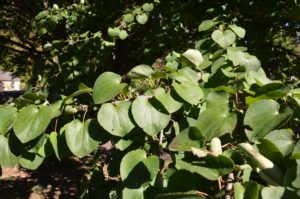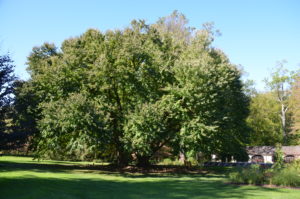Katsura Tree (Cercidophyllum japonicum) is a medium to large tree indigenous to China, Korea and Japan (USDA hardiness zones 4-8). Fossil imprints indicate that Katsura Tree has existed over 1.8 million years and flourished throughout Asia and North America. Katsura’s genus name Cercidophyllum translates to “leaf (phyllum) like a red bud (Cercis)”.
A mature tree can reach a height of 40-60 feet and spread of 35-60 feet. The tree may be single or multi-trunked. Summer heart-shaped leaves are light green and mimic that of redbuds in appearance. Redbud produces larger heart-shaped leaves with entire (toothless) leaf margins.
Katsura Tree is dioecious species, e.g. male and female flowers are on different trees. Male and female trees differ in form. Male trees tend to grow more upright and tall, female trees are wider in appearance. Flowers are small and most people don’t notice when the tree is blooming in late March. In autumn, the entire tree is aglow in yellow and there a whiff of cinnamon or caramelized sugar in the air.
Katsura Tree is best grown in rich, moist, well-drained soils and in full sun to partial shade. It prefers a moderately acidic to slightly alkaline soil pH. This beautiful ornamental tree may partially sheds some leaves seasonally, particularly a young tree, as a response to hot dry weather. Katsura Tree produce few viable seeds.
The branch and trunk wood of a mature tree is a major asset along with the tree’s architectural form in the winter landscape. As the tree ages, the trunk may take on a shaggy appearance. Katsura Tree roots are shallow; thus a lawn may be difficult to maintain. Roots of older trees may raise sidewalks.
Don’t expect to find Katsura Tree and cultivars thereof at local garden centers. However, it can be offered by online nurseries.
Significant Cultivars:
‘Rotfuchs’ (“RED FOX”) produces new leaves emerge deep burgundy-purple in spring, later turning blue green in summer.
‘Aureum’ produces that leaves that emerge purplish in spring and mature to bright yellow by summer.
‘Pendula’ are graceful weeping forms with pendulous branching. ‘Tidal Wave’ and ‘Amazing Grace’ are other weeping forms.



 Posted in
Posted in 
